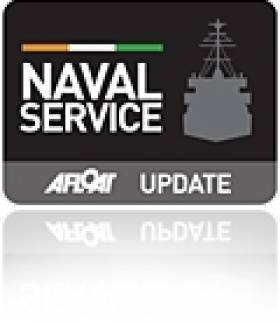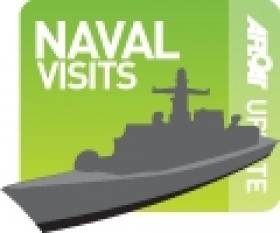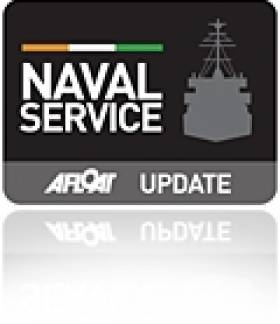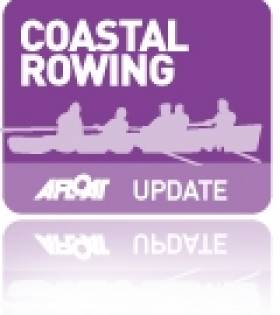Displaying items by tag: Navy
Ports & Shipping Review: New Tallships Race and Cruise Operators, Superpower Naval Visitors, School at Sea, Irish Sea Excursions and Wind-Farms
#PORTS & SHIPPING REVIEW - Over the last fortnight Jehan Ashmore has reported from the Shipping scene where after the Irish Navy's role in the Tallships 'Parade of Sail', the inaugural Irish Sea Tall Ships Race finally got underway to Liverpool.
Also making a call to Dublin Port was cruise newcomer Plantour & Partners's whose small cruiseship Hamburg made her debut visit to the capital port.
The following day saw the classic cruiseship veteran Princess Daphne call, she was launched originally as a general cargo-ship serving the UK-Australia and New Zealand trade routes. In the same week her sister Princess Danae was arrested in Dublin Port, for an alleged non-payment of fuel bills. The dispute was eventually settled which saw the H&W built vessel depart for La Rochelle.
Operating profits at Irish Ferries of €3.2m for the first six months of 2012, remained the same compared to the same period last year, according to its parent company ICG which released its financial interim report.
A special call by the USS Fort McHenry (LSD-43), a dock landing ship to Dublin Port was made to coincide with American Football Week which allowed her crew to attend the Emerald Isle Classic showdown between the Navy and Notre Dame. On a related note US students where making their 'Semester at Sea' cruise on board Explorer which had called to Galway Bay and later the capital.
With the US Navy in Dublin, the rebel county had its own rare visit of the Russian Navy, when the destroyer Vice-Admiral Kulakov (626) called to Cobh. On both occasions the public were able to board.
Glasgow based Waverley Excursions have been running several unusual route excursions out of Northern Ireland. The final excursion was scheduled for today with a day-trip between Portaferry, Co. Down and Peel on the west coast of the Isle of Man.
While on waters off the east coast of the Irish Sea's largest island, proposals for an extended wind-farm will not require re-routing of shipping lanes according to developer Dong Energy. They operate the Walney Island wind-farm off Cumbria.
Naval Service Detain Irish Trawler off Roches Point
#FISHERY DETENTION – An Irish registered fishing vessel was detained by the Naval Service OPV L.É. Aoife (P23) today some 60 miles south-east of Roches Point, Co. Cork.
The detention was in relation to alleged under-recording of catch and other alleged breaches of fishing regulations. Currently the L.É. Aoife is escorting the detained vessel which is expected to berth alongside Cobh later this evening and handed over to the Gardaí.
So far this year, the Naval Service has carried out 1014 inspections, issued 36 vessel warnings for 42 infringements detected and detained 15 vessels for 39 detected infringements.
Rare Opportunity As Russian Destroyer Opened to the Public
#RUSSIAN NAVY - While Dublin Port was visited by USS Fort McHenry (LSD-43) over the last week, the Russian Navy's Vice-Admiral Kulakov (626) paid a courtesy call to Cork Harbour, berthing at Cobh, normally associated with frequent cruise callers, writes Jehan Ashmore.
The imposing Udaloy anti-submarine destroyer berthed alongside Cobh's deepwater quay last week, where the public had rare access to board the 162m destroyer commissioned in 1982.
Later this month the Cork Harbour Open Weekend (15-16th Sept) as previously reported on Afloat.ie will offer two-days of fun filled activities for all ages, with events and activities for all, both on and off the water.
US Navy Dock Landing Ship Departs Dublin Bay’s Shipping Scene
#US NAVYSHIP DEPARTS – At lunchtime the United States Navy dock-landing ship USS Fort McHenry (LSD-43) departed Dublin Port, after her visit for American Football Week, writes Jehan Ashmore.
Waiting out in Dublin Bay was the Irish Naval Service 'flagship' L.E. Eithne (P31) which had gone to anchorage having also stayed in the capital concurrently to the naval visitor. As USS Fort McHenry headed out on an easterly direction L.E. Eithne got underway too and proceeded southbound.
Other shipping activity in the bay included Seatruck Ferries newbuild freight-only ferry, Seatruck Progress, the ro-ro vessel serves on the Dublin-Liverpool route. Also at anchorage was Broström Tankers coastal tanker Bro Genius (2003/4,107grt).
Further out in the bay at the North Burford Buoy was Dublin Port Company's multi-cat Rosbeg, the workboat tender craft performs a wide variety of duties inside and outside the port, from cleaning the river to quay maintenance, bed levelling and buoy-handling.
Closer to shore, nearer to Dun Laoghaire Harbour was the cutter Cosantoir Bradan (meaning Salmon Defender) which as previously reported is on charter from the Central Fisheries Board to the Geological Survey of Ireland (GSI). They are using the cutter in conjunction with their RV Keary for survey work, including bottom surveying.
RV Keary attended the Dublin Tall Ships Races Festival, where she was moored in Grand Canal Dock which was also occupied by a fleet of narrowboats moored at the marina of the Waterways Visitor Centre.
West Meets East: As Semester at Sea Ship Heads for The Gathering
#SEMESTER SHIP – Having made a recent visit to Galway, the cruiseship Explorer with more than 800 students, academics and crew are on board, as previously reported on Afloat.ie, is currently heading to the opposite side of the island, with a visit to Dublin Port, writes Jehan Ashmore.
The 25,000 tonnes vessel with its floating campus is due to dock in the capital tomorrow morning at Ocean Pier. The 180m vessel, formerly the Olympic Explorer built in 2000 for Royal Olympic Cruises is currently providing a "semester at sea" (SAS) programme through a world tour.
The SAS is operated on a not-for-profit initiative for the Institute for Shipboard Education, in co-operation with the University of Virginia in the US. Students taking the educational programme had set off on the world voyage from Halifax, Nova Scotia, with the first leg to Galway.
When Explorer berths in Dublin Port, she will join the United States Navy landing ship USS Fort McHenry (LSD-43) which as previously reported on Afloat.ie had already arrived last Thursday for the American Football Week.
It was downriver from her Ocean Pier berth at the nearby O2 Arena, where last night's televised "The Gathering: Notre Dame- A Welcome Home" , a special concert which was held for fans in the Docklands venue.
Today the Emerald Isle Classic with 33,000 fans of the games two big boys, Notre Dame and the Navy, is been held this afternoon, on the far side of the Liffey at the Aviva Stadium.
After her two-day call to Dublin the Explorer continues on its global tour with calls to the UK, Belgium, Portugal, Spain, Morocco, Ghana, South Africa, Argentina, Uruguay, Brazil and Dominica.
#USS NAVY VISIT - The United States Navy landing-ship USS Fort McHenry (LSD-43) is to make a courtesy call to Dublin Port tomorrow, and remain for the next 11 days, so to include American Football Week, writes Jehan Ashmore.
She is scheduled to dock at Ocean Pier, berth 33, where the vessel will be available for public tours organised through a lottery held next weekend (1-2 September). To register for the tours, follow this visit: http://dublin.usembassy.gov/uss-fort-mchenry.html
To see more information about USS Fort McHenry, www.fort-mchenry.navy.mil/
The United States Naval Academy will host the University of Notre Dame this September 1st in their annual NCAA fixture. For only the second time since this great fixture started in 1927, the game will be played outside the United States, with Ireland's Aviva Stadium staging the match.
The response from the Irish and American public has been exceptional with tickets selling out almost six months ahead of the game. Over 30,000 US patrons will travel to Dublin for this game, making it one the biggest international sporting events to be staged in Ireland in 2012.
For a list of events around the game click HERE.
The visit of USS Fort McHenry, is similar to that of the aircraft carrier, USS John F. Kennedy (CV-67) which anchored off Dun Laoghaire Harbour in 1996, again on that occasion, a lottery was held for the public during the visit of the 82,000 tonnes giant. Her call to Dublin Bay was during Jean Kennedy-Smith's tenure as US Ambassador to Ireland, and during the early days of the northern 'peace process'.
Returning to the present, the Irish Naval Service 'flagship' OPV L.É. Eithne (P31) arrived into the port today, albeit her call is of a typical short duration, where the 1,800 tonnes vessel will only make an overnight stay.
Notably she is the first and only Naval Service vessel to visit the US, when she visited Boston, Hamilton and New York in 1986. In addition the helicopter patrol vessel is the last naval vessel built in this state for the Naval Service and also is the last ever ship built in the the republic, when completed by Verolme Cork Dockyard in 1984.
It is ironic that the L.E. Eithne should visit the United States before making any call to Northern Ireland, which did not materilise until a historic first visit was made to Belfast Harbour in 2003. Her visit to the north was the first since partition in 1922 and the OPV docked in the port to where HMS Tyne was also berthed.
#NAVAL SERVICE – The Irish Maritime and Energy Resource Cluster (IMERC), based in Haulbowline, Co. Cork, has won an award at the Taoiseach's Public Service Excellence Awards.
Minister for Justice Equality and Defence, Alan Shatter TD, was delighted to congratulate the Irish Naval Service for the award won by IMERC. The Naval Service was one of four areas within his departments to win an award at a ceremony held yesterday in Dublin Castle.
The Minister said "IMERC is a unique example of joined-up-thinking across three public sector institutions, the Irish Naval Service as an element of the Defence Forces under the Department of Defence, University College Cork and the Cork Institute of Technology.
He added, "This collaboration has produced results that have leveraged major capital investment, succeeded in attracting inward investment, supported indigenous industry and enhanced capacity for research and innovation in Ireland's maritime sector."
The cluster concept is the first such project to have been selected for the Taoiseach's National Awards and in which was among 20 selected for its 'innovation' and potential 'excellence' of the 190 applications.
The developing IMERC campus is to feature the world's largest energy renewable centre. The cluster aims to create up to 52,000 jobs in the wave energy technologies sector by 2020.
LE Roisin Detains Spanish Fishing Vessel
The Naval Service Vessel LE Roisin detained a Spanish registered fishing vessel approximately 150 nautical miles off the Clare Coast yesterday afternoon. The detention was in relation to an alleged breach of technical fishing regulations.
The vessel is currently under escort by the LE Roisin to Castletownbere and is expected to arrive alongside today. The vessel will then be handed over to the Gardai.
The Naval Service carried out 1,313 boardings and eight detentions of vessels off the Irish Coast in 2011.
To date in 2012 the Naval Service has boarded and inspected 412 vessels, issued 14 warnings and detained three vessels for irregularities.
Navy Detain UK Registered Trawler
#NAVAL SERVICE – The LÉ Aisling (P23) detained a British registered fishing vessel approximately 180 nautical miles west of the Skelligs last night. The detention was in relation to an alleged breach of fishing regulations.
According to the Naval Service the vessel was expected to arrive under escort to Castletownbere this morning and handed over to the Gardaí.
This was the first detention of 2012 and so far there have also been 51 boardings this year. In 2011 the Naval Service carried out 1,313 boardings and 8 detentions of vessels.
Bantry 2012 Launches 'Seamanship Challenge' this Month
#BANTRY2012 – A spectacular display of seamanship for Cork this Summer will be officially launched by Minister for the Marine Simon Coveney TD on January 27th when details of the Bantry 2012 Challenge are revealed. As well as a top sporting story organisers say it's also a tale of how tight knit coastal communities across the world have forged strong interantional links thanks to an initial idea in West Cork.
300 competitors from 16 nations are expected in July when replicas of the Bantry Bay longboat, the oldest surviving vessel in the French navy are raced under sail and oar.
The international crews will take part in a week long event in ten events both on and off the water. The prestigious event for the West cork venue is known as the 'Atlantic Challenge Bantry Bay Gig World Championships'.
Two years ago, as previously reported in Afloat, the Bantry Bay crew, soared in second place, while representing Ireland in the Atlantic Rowing Challenge in Midland Canada.
Competing on Lake Huron, one of the five Great Lakes the Bantry Bay Crew displayed huge amounts of physical and mental strength as they accomplished first place in their first three races.
The Atlantic Challenge is held every other year and sponsors a friendly contest of seamanship in Bantry Bay gigs. Founded by an American native Lance Lee, the Atlantic Challenge aims to build trust among nations and form a community of youth and adults from many countries, while also encouraging the practice of traditional maritime skills.
The boats measure almost 40-foot in length and hold 13 crew. Each boat uses a mainsail, foresail and mizzen.
The competition starts in Bantry on July 21st.






































































